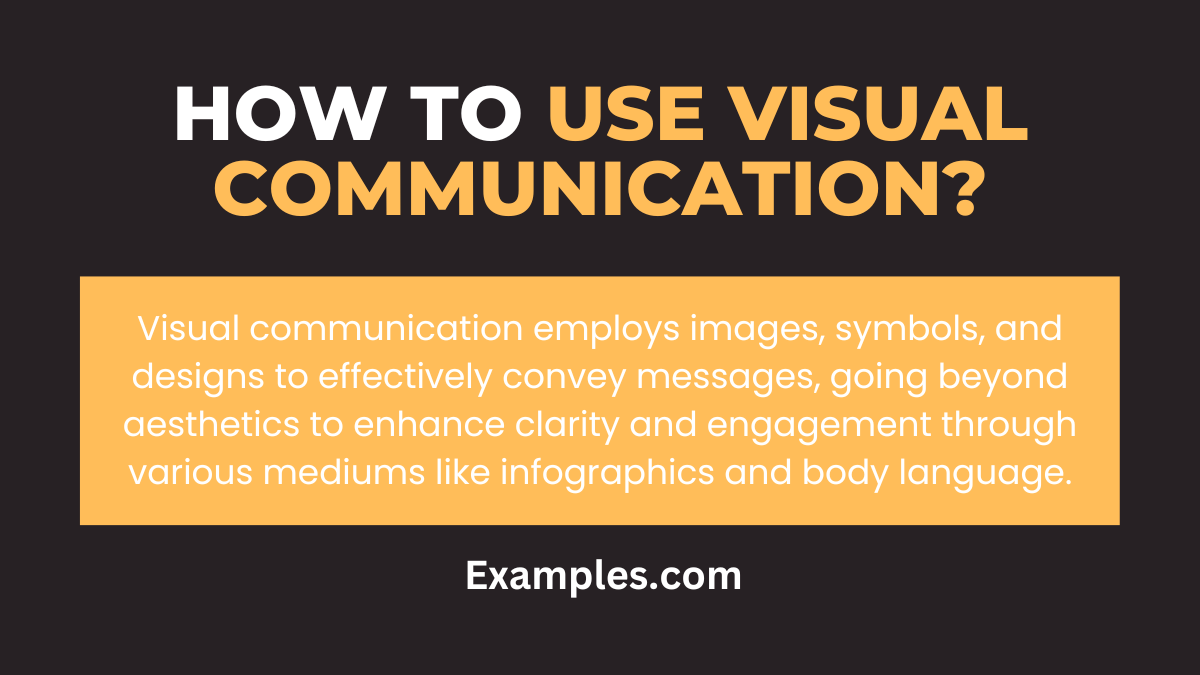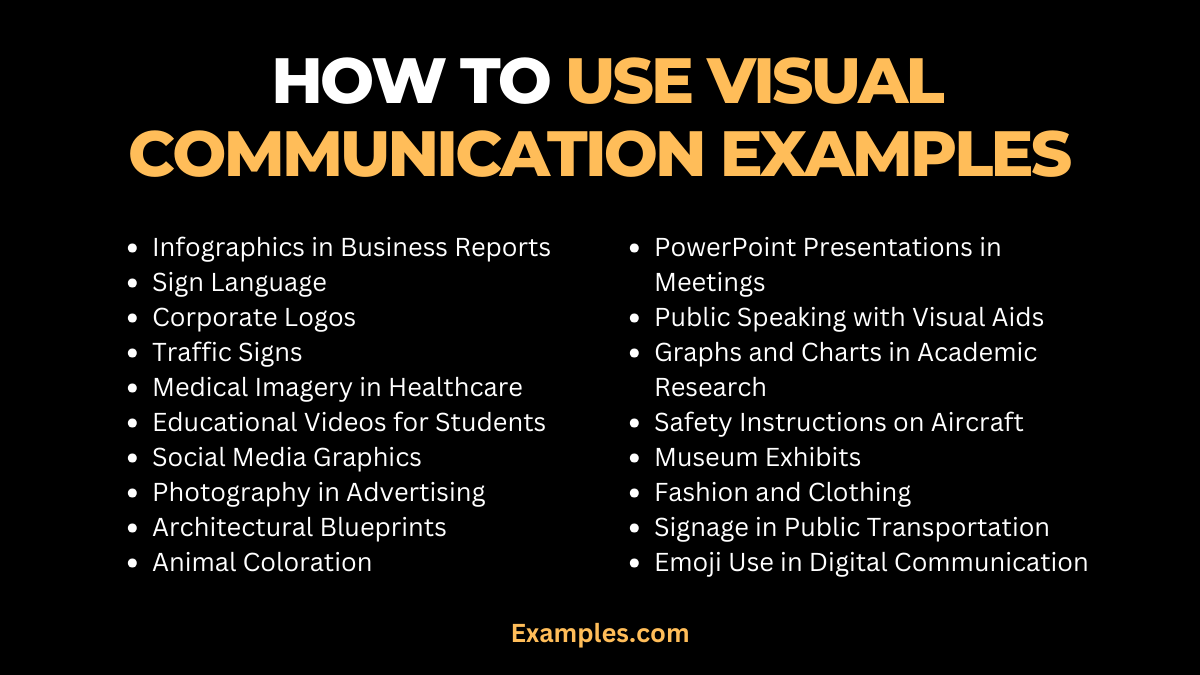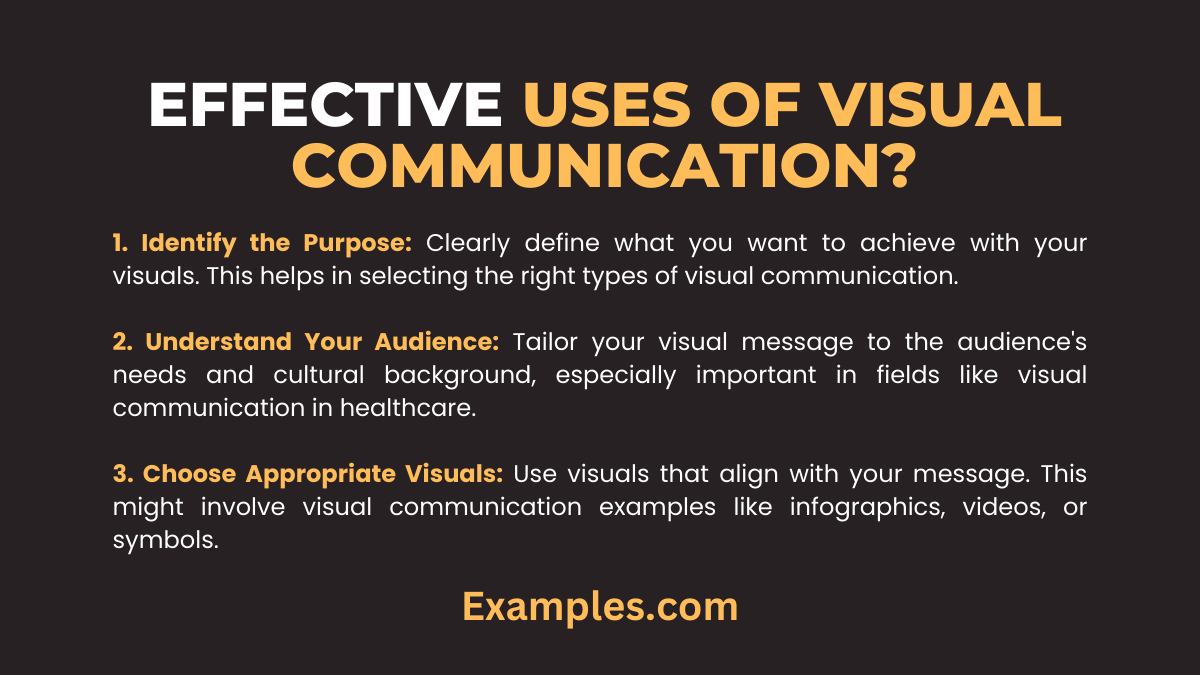How to Use Visual Communication – 19+ Examples
Visual communication, a cornerstone of effective messaging, harnesses visuals to convey ideas and information. This comprehensive guide delves into the nuances of this dynamic method, providing rich, practical Communication Examples to illustrate its power. From the boardroom to the classroom, visual communication transcends barriers, offering clarity and engagement. Understanding its principles is crucial in a world increasingly reliant on visual cues. Here, we explore how to utilize visual communication with examples that bring theory to life, enhancing both personal and professional interactions.
Download Visual Communication in Daily Life PDF
How to Use Visual Communication?

Using visual communication means employing visual elements to convey messages or information. This method involves the strategic use of images, symbols, colors, and designs to express ideas or data. In simple terms, it’s like speaking through pictures instead of words.
Visual communication is not just about making things look attractive; it’s about using visuals effectively to make your message clearer and more engaging. This can be done through various mediums such as infographics, charts, signs, symbols, and even body language.
20 How to Use Visual Communication Examples

Visual communication plays a pivotal role in conveying messages with clarity and impact. This guide provides 20 unique and distinct examples, showcasing the breadth and versatility of visual communication in various contexts. From graphic design to nonverbal cues in the animal kingdom, these examples highlight the importance of visual communication and its diverse types. Each example is accompanied by an explanation to demonstrate how visual communication can be effectively utilized in different scenarios, whether in the workplace, media, or even in nature.
- Infographics in Business Reports: Simplify complex data for easy understanding and quick decision-making.
- Sign Language: A powerful tool for the deaf community, demonstrating the importance of visual communication.
- Corporate Logos: Symbolize brand identity, leveraging visual communication vs graphic design principles.
- Traffic Signs: Provide crucial information quickly and effectively, a prime example of how visual communication works.
- Medical Imagery in Healthcare: Assist in diagnosis and treatment, showcasing visual communication in healthcare.
- Educational Videos for Students: Enhance learning through visual aids, illustrating how to use visual communication in education.
- Social Media Graphics: Engage audiences and convey messages swiftly, a modern application of visual communication in the media.
- Photography in Advertising: Create emotional connections with consumers, a blend of visual communication and photography.
- Architectural Blueprints: Convey detailed construction plans, highlighting the characteristics of visual communication.
- Animal Coloration: Communicate threats or attract mates, an example of visual communication in animals.
- PowerPoint Presentations in Meetings: Communicate ideas effectively in the workplace, demonstrating visual communication in the workplace.
- Public Speaking with Visual Aids: Enhance message retention and engagement.
- Graphs and Charts in Academic Research: Present data in a digestible format, a practice noted in the visual communication journal.
- Safety Instructions on Aircraft: Quick, visual instructions for passenger safety.
- Museum Exhibits: Educate and engage visitors through visual storytelling.
- Fashion and Clothing: Communicate personal style and cultural identity.
- Signage in Public Transportation: Guide passengers efficiently, utilizing visual communication vs written communication techniques.
- Emoji Use in Digital Communication: Add emotional context to text, a new era visual communication example.
- Braille on Public Signage: Assist visually impaired individuals, a unique form of visual communication.
- Pictograms in Public Spaces: Universal communication, transcending language barriers.
These examples underscore the versatility and effectiveness of visual communication across various fields, from visual communication jobs, careers, salaries to its role in visual communication in insects and beyond. Understanding and applying these principles can significantly enhance the way we share and interpret information.
How to Use Visual Communication for Students
Visual communication is a crucial skill for students, enhancing learning and engagement through visual aids. It involves using images, charts, and interactive media to simplify complex concepts and foster a more inclusive learning environment. This approach taps into the visual learning style, making education more effective and enjoyable.
- Interactive Whiteboards: Enhance classroom engagement with real-time illustrations.
Example: Drawing a diagram on an interactive whiteboard to explain the water cycle. - Educational Infographics: Simplify complex information into engaging visuals.
Example: Using an infographic to summarize the key events of the American Revolution. - Mind Maps: Aid in organizing thoughts and improving memory.
Example: Creating a mind map to outline the main themes of a novel. - Flashcards with Images: Enhance memory recall with visual cues.
Example: Using image-based flashcards to learn vocabulary. - Video Presentations: Make learning dynamic and interactive.
Example: A student-created video presentation on environmental conservation.
How to Use Visual Communication in Business
In business, visual communication is used to convey messages clearly and effectively, enhancing brand identity and marketing strategies. It involves creating visual content that aligns with the company’s values and goals, ensuring consistent and impactful messaging.
- Branding Elements: Create a strong brand identity with logos and color schemes.
Example: A logo that combines the company’s initials with its signature colors. - Marketing Collaterals: Attract and engage customers through visually appealing materials.
Example: Designing eye-catching brochures for a new product launch. - Data Visualization: Present complex data in an understandable way.
Example: Using a bar graph to demonstrate quarterly sales growth. - Corporate Presentations: Communicate company objectives and achievements.
Example: A slide deck with visuals highlighting annual milestones. - Product Demonstrations: Showcase features and benefits visually.
Example: A video demonstration of a new tech gadget’s features.
How to Use Visual Communication at Work
Visual communication at work involves using visual elements to facilitate understanding and efficiency in the workplace. It includes everything from presentations and reports to office signage, all aimed at enhancing communication and productivity.
- Project Roadmaps: Clarify project timelines and milestones.
Example: A Gantt chart outlining the phases of a project. - Organizational Charts: Visualize company structure and roles.
Example: A diagram showing the hierarchy within the organization. - Safety Signage: Convey important safety information effectively.
Example: Signs indicating emergency exits and procedures. - Process Flowcharts: Illustrate the steps in a process or system.
Example: A flowchart detailing the customer service process. - Internal Communication Screens: Share news and updates visually.
Example: Digital screens displaying company news and employee achievements.
How To Use Visual Communication and Why It Matters?
Visual communication is a powerful tool in conveying messages in a clear, concise, and visually appealing manner. It encompasses the use of images, symbols, colors, and designs to communicate ideas effectively, transcending the limitations of language and text. In this guide, we explore the importance of visual communication, its applications, and how to harness its power in various contexts.
Why Visual Communication Is Essential
- Enhances Understanding: Visuals help in breaking down complex information into digestible pieces, making it easier to understand.
- Broad Reach: It transcends linguistic barriers, making it ideal for global communication, highlighting the visual communication vs written communication aspect.
- Increases Engagement: Visual elements are more likely to catch and retain the viewer’s attention, a key component in visual communication in the media.
- Improves Memory Retention: People tend to remember visual information better than text, underlining the importance of visual communication.
- Facilitates Emotional Connection: Visuals can evoke emotions, making messages more impactful.
What are the Effective Uses of Visual Communication?

- Identify the Purpose: Clearly define what you want to achieve with your visuals. This helps in selecting the right types of visual communication.
- Understand Your Audience: Tailor your visual message to the audience’s needs and cultural background, especially important in fields like visual communication in healthcare.
- Choose Appropriate Visuals: Use visuals that align with your message. This might involve visual communication examples like infographics, videos, or symbols.
- Keep It Simple and Clear: Avoid clutter in your visuals. Simplicity ensures your message is easily understood, a principle often emphasized in visual communication journals.
- Incorporate Storytelling: Use visuals to tell a story, making the message more relatable and memorable.
- Use Technology and Tools: Leverage various visual communication tools and resources to create high-quality visuals.
- Feedback and Adaptation: Gather feedback and be prepared to adapt your visuals for better effectiveness, a practice integral to how visual communication works.
How do you manage visual communication?
Effective management of visual communication involves understanding your audience, choosing appropriate visuals, and ensuring consistency and clarity in your message. Continuous learning and adaptation are key.
What does visual communication look like?
Visual communication appears as images, symbols, charts, and videos, effectively conveying messages without words. It’s seen in mediums like graphic design, infographics, and visual media.
How does visual communication help in our everyday lives?
Visual communication simplifies complex information, enhances learning, and aids in quick decision-making. It’s integral in education, healthcare, marketing, and everyday media interactions.
In conclusion, visual communication, through its varied examples, is an indispensable tool in our information-rich world. By effectively employing visuals, we can enhance understanding, engagement, and retention across multiple domains. Whether in education, business, or everyday interactions, mastering the art of visual communication is crucial for conveying complex ideas simply and powerfully, bridging gaps in understanding and connecting with audiences more meaningfully.
In the dynamic world of communication, visual elements play a pivotal role in enhancing comprehension and engagement. Embracing visual communication means not only enriching your message but also connecting with your audience on a deeper level. For further insights into the power of visual communication, the American University School of Communication offers valuable resources (American University School of Communication). Additionally, exploring comprehensive guides and examples, such as those found at Meagherfest (Meagherfest Visual Communication), can provide practical approaches to implementing effective visual strategies. These resources underscore the importance of visual communication in our increasingly visual-centric world, offering tools and knowledge to harness its full potential.



